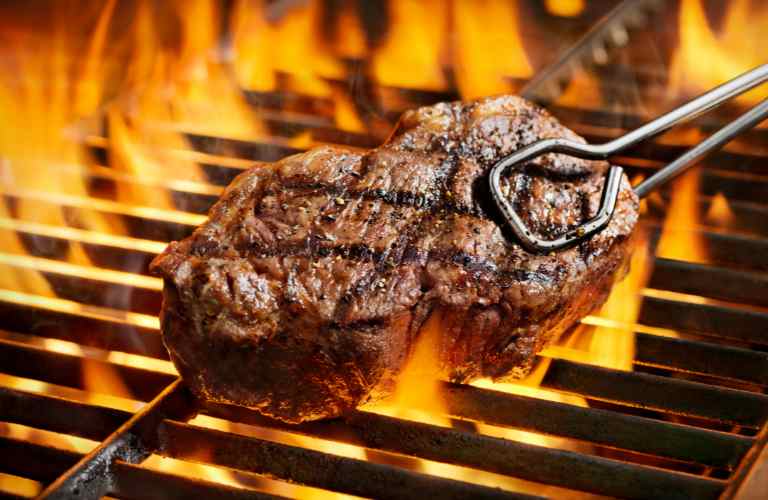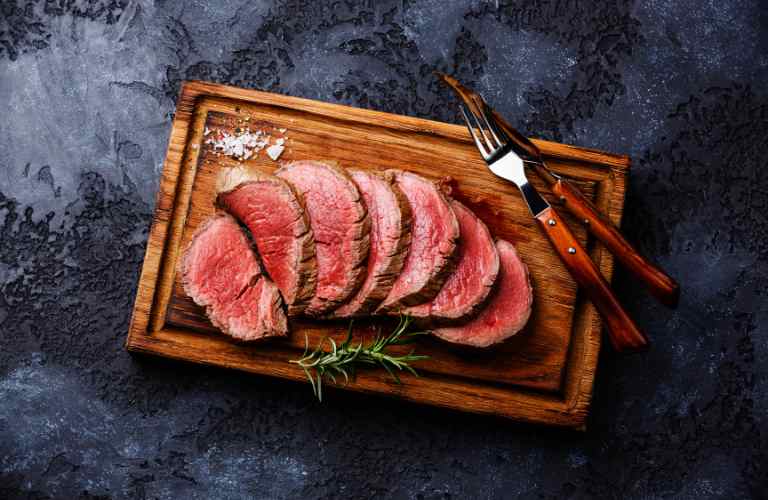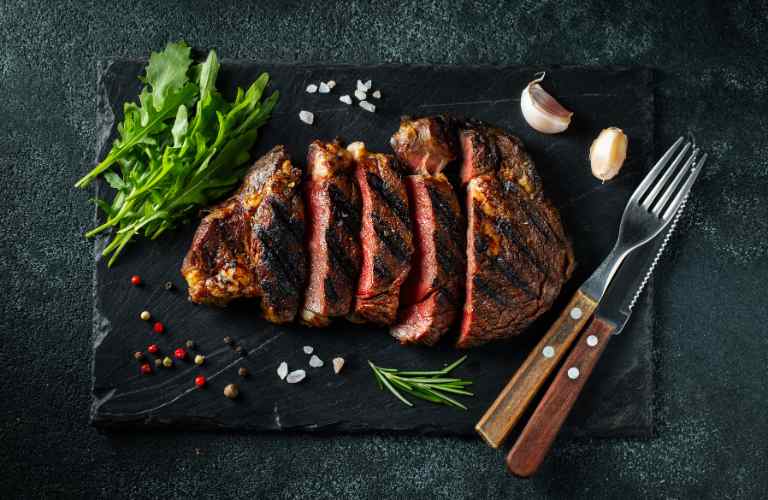Are you ready to embark on a tantalizing journey into the world of steaks? Whether you’re a meat lover or simply curious about this culinary delight, understanding the basics of steaks is essential to fully appreciate their flavor and tenderness.
In this ultimate beginner’s guide, we’ll dive into the fascinating realm of steaks, providing you with a comprehensive understanding of different cuts, cooking techniques, and even some expert tips.
So, grab your apron and get ready to become a steak connoisseur!
What is Steak?
At its core, steak is a prime cut of meat known for its tenderness and rich flavor.
It typically comes from beef, but can also be sourced from other animals like pork or lamb.

The origins of steak can be traced back to ancient times when humans discovered that certain parts of an animal yielded more succulent and satisfying meals.
Different Cuts of Steak
One of the most critical factors that contribute to the taste and texture of a steak is the cut of meat it comes from. Here are some popular cuts you should familiarize yourself with:
- Ribeye: The ribeye is known for its exceptional marbling, which translates into a rich and juicy eating experience. It’s a favorite among steak enthusiasts for its intense flavor and tenderness.
- Filet Mignon: If tenderness is what you seek, look no further than the filet mignon. This cut is renowned for its buttery smooth texture and subtle flavor. It’s often considered the most tender steak cut available.
- New York Strip: Offering a perfect balance between tenderness and flavor, the New York Strip, also known as the strip steak, is a classic choice. It boasts a robust beefy taste and a satisfying chew.
- T-Bone: The T-Bone steak is a two-in-one delight, consisting of two cuts: the tenderloin and the strip steak. This combination offers the best of both worlds—an incredibly tender portion (the tenderloin) and a flavorful one (the strip steak).
- Sirloin: A versatile and widely available steak, the sirloin offers a good balance of tenderness and flavor. It can be further divided into top sirloin and bottom sirloin cuts, each with its own unique characteristics.
Understanding the differences between these cuts will help you navigate the steak landscape and choose the one that best suits your preferences.
Choosing the Perfect Steak
When it comes to selecting a steak, a few key factors should influence your decision. Paying attention to these aspects will ensure you end up with a high-quality and delicious piece of meat.

Grade of Beef
Beef steaks are commonly graded based on their quality. The United States Department of Agriculture (USDA) employs a grading system that categorizes beef into three main grades:
- Prime: This is the highest grade of beef, reserved for steaks with abundant marbling, resulting in exceptional flavor and tenderness. Prime steaks are often found in upscale restaurants and specialty butcher shops.
- Choice: The Choice grade represents high-quality beef with less marbling than Prime. Choice steaks are still tender and flavorful, making them a popular choice for home cooking.
- Select: The Select grade consists of leaner beef with minimal marbling. While it may lack the same level of tenderness and flavor as Prime or Choice, Select steaks can still be delicious when cooked properly.
Consider the grade of beef when making your selection, keeping in mind that higher grades tend to offer a more indulgent steak experience.
Cut of Steak
The cut of steak plays a significant role in determining its texture, tenderness, and flavor profile.

Different muscles within the animal yield various cuts, each with its own characteristics.
Understanding the cut will help you choose a steak that aligns with your desired eating experience.
Marbling and Fat Content
The marbling—the intramuscular fat dispersed throughout the steak—is a crucial aspect to consider.
Marbling greatly contributes to the tenderness, juiciness, and flavor of the meat. More marbling typically means a more succulent and flavorful steak.
Assessing the marbling and fat content will guide you towards a steak that suits your preferences.
Freshness and Aging
Freshness is another crucial factor when selecting a steak. Look for meat that has a vibrant color, firm texture, and is free from any unpleasant odors.
Additionally, some steaks benefit from aging, which involves storing the meat under controlled conditions to enhance tenderness and flavor.
Aging can be done through two methods: wet aging (in vacuum-sealed packages) or dry aging (exposed to air in a controlled environment). Both methods can produce exceptional results, but dry-aged steaks are known for their distinct, concentrated flavor.
Armed with the knowledge of beef grading, different cuts, marbling, and aging, you’ll be equipped to choose a steak that suits your preferences and guarantees a memorable dining experience.
Preparing and Cooking Steaks
Now that you’ve selected the perfect steak, it’s time to prepare and cook it to perfection. Proper preparation and cooking techniques are essential to bring out the best flavors and textures in your steak.
Preparing the Steak
Before cooking, consider the following steps to enhance the taste and tenderness of your steak:
- Seasoning: Seasoning your steak is an important step to enhance its flavor. You can keep it simple with just salt and pepper or explore various marinades and dry rubs to add extra depth of flavor.
- Bringing to Room Temperature: Allow your steak to come to room temperature before cooking. This ensures more even cooking throughout the steak.
Cooking Methods
There are several cooking methods you can choose from, each offering its unique advantages and results. Here are three popular methods:
- Grilling: Grilling a steak over an open flame imparts a smoky flavor and beautiful grill marks. It’s ideal for thicker cuts and allows for greater control over the level of doneness.
- Pan-Searing: Pan-searing involves cooking the steak in a hot skillet with a little oil or butter. This method creates a flavorful crust on the steak while maintaining its tenderness.
- Broiling: Broiling involves cooking the steak under high heat in the oven. It’s a quick and convenient method that produces a delicious result, especially for thinner cuts.
Cooking Times and Doneness Levels
Achieving your desired level of doneness is crucial for a perfectly cooked steak. Here are the general cooking times and temperatures for different levels of doneness:
- Rare: Cooked for a short time, resulting in a cool red center. Internal temperature: 125°F (51°C).
- Medium Rare: Cooked for a bit longer, with a warm red center. Internal temperature: 135°F (57°C).
- Medium: Cooked to a rosy pink center. Internal temperature: 145°F (63°C).
- Well-Done: Cooked thoroughly with no trace of pink. Internal temperature: 160°F (71°C) or above.
Remember that these temperatures are just guidelines, and personal preferences may vary. Use an instant-read thermometer to ensure accuracy.
Resting and Slicing
After cooking, it’s crucial to let your steak rest for a few minutes before slicing and serving.
Resting allows the juices to redistribute within the meat, resulting in a juicier and more flavorful steak. When slicing, cut against the grain to ensure tender bites.
Serving and Pairing Steaks
Now that your steak is perfectly cooked, it’s time to savor it with some delightful accompaniments and pairings.
Presentation Tips
When serving your steak, consider the following presentation tips:
- Plating: Place the steak on a clean plate, allowing it to be the star of the show. You can add some garnishes like fresh herbs or a drizzle of sauce for an elegant touch.
- Slicing: Slice the steak into thin, even pieces for easy consumption and an appealing presentation.
Accompaniments and Side Dishes
Pair your steak with these popular accompaniments and side dishes to complement its flavors:
- Mashed Potatoes: Creamy mashed potatoes provide a comforting and classic pairing with steak.
- Grilled Vegetables: Lightly charred and seasoned vegetables add a fresh and healthy element to the dish.
Sauces and Toppings
Enhance the flavors of your steak with these delectable sauces and toppings:
- Peppercorn Sauce: A creamy and tangy peppercorn sauce adds a burst of flavor to the steak.
- Blue Cheese Topping: The sharp and creamy notes of blue cheese create a fantastic pairing with a juicy steak.
Appreciating Steaks: Tips and Etiquette
To truly appreciate steaks, consider the following tips and etiquette:
- Sensory Experience: Take your time to savor the flavors, textures, and aromas of the steak. Notice the tenderness, juiciness, and richness in every bite.
- Etiquette: When dining out, use proper steak-eating etiquette, such as cutting one piece at a time, chewing with your mouth closed, and using appropriate utensils.
- Palate Development: Explore different cuts, cooking styles, and regional steak dishes to develop your palate and expand your steak knowledge.
Conclusion
Congratulations! You’ve completed the ultimate beginner’s guide to steaks. Armed with the knowledge of cuts, cooking techniques, and pairing options, you’re now ready to embark on a culinary journey of exploring and savoring the world of steaks.
So fire up the grill or heat up the skillet, and prepare to indulge in the mouthwatering delight of perfectly cooked steaks. Happy dining!
Still have the appetite to learn more? Here are some frequently asked queries…
What is the difference between dry-aged and wet-aged steaks?
Dry-aged steaks are exposed to controlled environments with specific temperature and humidity conditions for an extended period, typically weeks.
This process allows the steak to naturally tenderize and develop more concentrated flavors.
On the other hand, wet-aged steaks are vacuum-sealed and aged in their own juices, which helps enhance tenderness but may not produce the same intense flavor as dry-aged steaks.
How can I determine the doneness of a steak without using a thermometer?
While using a meat thermometer is the most accurate way to determine doneness, you can also employ the touch method.
By gently pressing the steak with your finger and comparing the resistance to different parts of your hand (e.g., the base of your thumb for rare, the middle for medium-rare, etc.), you can get a rough estimate of doneness.
However, this method requires practice and may not be as precise as using a thermometer.
Are there any vegetarian or vegan alternatives to steak?
Yes, there are various vegetarian and vegan alternatives to steak that aim to replicate the texture and flavor of traditional meat-based steaks.
These alternatives are typically made from plant-based ingredients like soy, wheat gluten (seitan), or vegetables.
Some popular options include tofu steaks, tempeh steaks, and portobello mushroom steaks.
Can I freeze steaks?
Yes, you can freeze steaks to extend their shelf life. It’s recommended to wrap the steaks tightly in plastic wrap or place them in a freezer-safe bag to prevent freezer burn.
When you’re ready to use them, thaw them in the refrigerator before cooking.
However, it’s important to note that the texture and quality of the steak may be slightly affected after freezing.
What is the best way to reheat leftover steak?
To preserve the tenderness and juiciness of leftover steak, it’s best to reheat it using methods that avoid overcooking.
One effective method is to gently warm the steak in a low-temperature oven (around 250°F or 120°C) until it reaches your desired level of warmth.
Alternatively, you can slice the leftover steak and quickly sear it in a hot skillet for a few seconds on each side.
Can I use marinades for all types of steaks?
Marinades can be used for various types of steaks, but it’s important to consider the specific cut and its characteristics.
More tender cuts, like filet mignon, may not require extensive marinating as their natural flavor is already exceptional.
However, tougher cuts can benefit from marinades that help tenderize the meat and infuse additional flavors.
Experiment with different marinades and consider the specific needs of the steak you’re working with.
How can I make my steak more tender?
To make your steak more tender, consider using techniques like marinating, dry-aging, or tenderizing with a meat mallet.
Marinating the steak with acidic ingredients like lemon juice or vinegar can help break down the muscle fibers and enhance tenderness.
Dry-aging allows natural enzymes to tenderize the meat over time. Tenderizing with a meat mallet involves pounding the steak to break down the fibers and make it more tender.
Are there any health concerns regarding the consumption of red meat?
While red meat can be enjoyed as part of a balanced diet, it’s important to consume it in moderation.
Excessive consumption of red meat has been associated with an increased risk of certain health conditions, such as heart disease and certain types of cancer.
It’s advisable to incorporate a variety of protein sources in your diet, including lean meats, poultry, fish, legumes, and plant-based proteins.
Can I cook a steak in the oven if I don’t have access to a grill or stovetop?
Yes, you can cook a steak in the oven using a method called oven broiling.
Preheat the oven to the broil setting and place the steak on a broiler pan or a wire rack set over a baking sheet.
Cook the steak for a few minutes on each side, depending on the desired level of doneness. Keep a close eye on the steak as broiling can quickly cook the meat.

